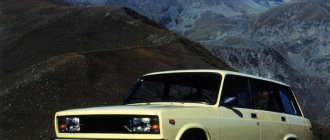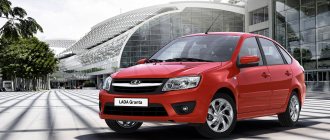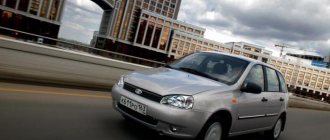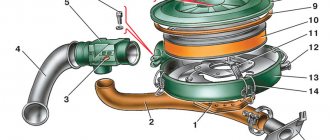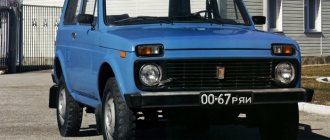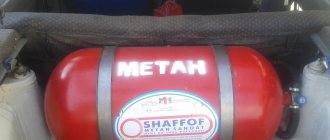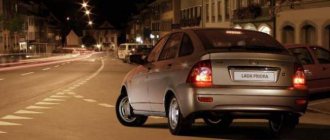Rated fuel consumption is one of the most informative and important characteristics of a car for the driver. This is what manufacturers often use to advertise and promote a particular new car model.
Among owners of used cars, it is considered acceptable to consume up to 10 liters of gasoline or diesel per 100 kilometers. In foreign countries, this indicator is indicated in miles, so recalculation into “native” units is often necessary. The fuel consumption tables available in this section of the site are considered very useful.
What does the fuel consumption indicator indicate? What does this characteristic mean? We are talking about hydrocarbon fuel consumption. For example, for an SUV the figure corresponds to 9.5 liters per 100 km. It is quite acceptable, primarily due to the weight and power of the car. The indicator can be reduced due to the following:
- use of energy recovery systems during braking;
- lightening the weight of the car when replacing body and chassis elements with innovative materials;
- engine improvements;
- replacing the exhaust system.
For new models, consumption of 6 l/100 km is considered quite a “cruising” figure, but it will be higher for heavy SUVs and pickups and lower for small hybrids. The necessary information can be found in the tables provided.
What to do if fuel consumption is higher than rated? If the car consumes more fuel and does not correspond to the nominal value indicated in the table, this means there is a malfunction. Experienced service center technicians will tell you how serious it is and how it can be eliminated. In some cases, tuning makes it possible to further optimize fuel consumption, but this is usually achieved by lightening the body structure or by replacing the engine. Professional automotive technicians can provide specific recommendations.
Fuel consumption of the Lada 4×4 Urban ranges from 9.7 to 9.9 liters per 100 km.
Lada 4×4 Urban is available with the following types of fuel: Gasoline AI-95.
Design
In the photo below, there are two versions of the Niva. On the left is the updated Urban, on the right is the one that was produced 40 years ago.
It is worth noting that the design of the car has truly “urbanized”. The car began to look like a compact urban crossover. Nevertheless, it has not lost its former off-road qualities. Several elements were worked into the design. Thus, the SUV acquired new front and rear bumpers, a radiator grille and wheels. The side mirrors have also been slightly modernized - they are now equipped with electric heating. But this option is not available on all Niva 4x4 Urban vehicles. Owner reviews note that heated mirrors are only available in the luxury version. The shape and design of the grille have been worked out to the smallest detail. The same goes for the bumper. The car does not seem outdated in 2022, which cannot be said about the other, previous versions. What else attracts the attention of the Niva Urban SUV? Owner reviews note that the car received a new, metallic color. This makes her noticeable in the gray traffic. But the car looks most impressive in white.
This SUV will definitely not leave you indifferent. Another feature of the new jeep is alloy wheels. They are already included in the maximum configuration of the Niva Urban car. Reviews from owners say that the design of the wheels looks great with the overall, updated silhouette of the Niva. Well, the designers deserve a solid “5”.
Decent appearance
Many drivers strive to express their individuality and give their car distinctive features. That’s why the appearance of the car is so important to them. To update the 5-door Niva, owners look at tuning photos on websites and get acquainted with the work of the masters.
You will definitely need to completely repaint the body. Most often, this is not a conventional procedure, but using liquid rubber or gluing with a more expensive carbon film. It is durable, which is why many owners choose it.
They paint the car in some unusual color or select several shades, harmoniously combining them with each other. There are fans who paint their car in contrasting colors.
Many people love 3D airbrushing. There are so many options here that one can only be surprised, admiring the imagination of some owners. This method is used so that the car can stand out significantly and become an exclusive example.
The photo of the 5-door Niva tuning in black or white looks especially impressive.
The advantages of this type of painting are undeniable:
- when applying a pattern using a special coating, the body acquires additional protection from external damage;
- the appearance of the car compares favorably with others;
- scammers are unlikely to risk stealing such a car - it is too noticeable;
- the drawing itself can tell a lot about the owner, about his, for example, tough character.
Before agreeing to draw a drawing, you should consider the sketch, carefully considering the decision. Too “controversial” airbrushing may be of interest to traffic police officers.
The most common methods of this type of tuning are mainly:
- Traditional application method. This is an attractive tuning of the 5-door Niva 4x4. Photos of similar models, drawings or sketches are used in this case to enhance visual perception. The craftsman has a set of tools with which the design is applied to the body manually. In this case, the payment for work is usually higher, the more professional, talented and skillful the work is done.
- Digital way. It is considered the most progressive, since in this case they use PC-controlled equipment. A certain program already contains the required image, and it appears on the body thanks to a high-precision printer. The advantage of this method is that during work all the intended colors and shades will be clearly conveyed.
- Film method. The easiest way to decorate a car, since a ready-made film with a selected pattern is applied. For many drivers, this method is more acceptable due to the cheap price. The work can be completed in a short time. This coating provides good additional protection against damage. This type of tuning can be done independently if you have at least a little experience.
Salon
Let's move inside the car.
Unfortunately, the interior design remained virtually unchanged. Even the architecture of the front panel in the Niva Urban car has not changed. Reviews from owners note that it has become significantly outdated over the years and certainly does not look good with the updated design of the car. Among the significant improvements are new seats, which in luxury trim levels are equipped with electric heating, as well as a four-spoke steering wheel, vaguely reminiscent of a Sobolev steering wheel. By the way, the chairs have yellow stitching. The dashboard was borrowed from the “tens”. It’s not a good idea to take a panel from a car that was developed in the last century. Nevertheless, this whole “hodgepodge” fit on the “Zhiguli” torpedo, the architecture of which has not changed since Soviet times.
Inside you can see that the side mirrors are devoid of mechanical adjustment levers - now their position is set remotely, using an electric drive. The steering column remains the same. The lowering and differential locking levers have not changed their location either. They work on the same principle. A cup holder appeared, the design of the door cards changed. The glove compartment remains the same. There is a child seat mounting system at the rear. However, it is unlikely that future car owners will use this function. After all, the main element of the Niva is off-road, which is what they actually buy it for.
Old problems
After a couple of years, quite a lot of negative reviews have accumulated regarding the Niva Urban SUV (3 days). Specific owner reviews point to the old panel design. And if the developers managed to change the appearance by replacing the grille, bumpers and wheels, then even the presence of heated seats and power windows did not change the situation inside. The cabin simply rattles at speed - the sound insulation leaves much to be desired. There are huge gaps in the cabin. Plastic literally comes in waves, and this quality comes straight from the factory. But this is not all the hidden sides of the Niva 2131 Urban car.
Feedback from the owners allows us to conclude that the latter speak negatively about the stove. The adjustments are from the 70s, and the noise is comparable to the work of the turbines of a jet aircraft. The stove was an eternal problem for Niva. With the release of Urban it would have been very opportune to refine its design, but this did not happen. The transmission and transfer case control levers still stick out. Along the entire perimeter of the cabin, uncovered heads of screws and clamps are visible.
Specifications
Let's look at what engines the Niva Urban SUV is equipped with. Owner reviews say that there is only one 1.7-liter unit in the line, based on the old Zhiguli engine. The only difference is the injection intake system. This is where all the improvements end. The power of this engine, according to car owners, is frankly not enough. There are 2 valves per cylinder - in 2022, this timing technology is no longer used by anyone. The maximum power that this unit can develop is 83 horsepower. What is the fuel consumption of Niva Urban? Owner reviews say that, despite the “injector” type intake system, the car remains as voracious as ever. So, per 100 kilometers it consumes about 15 liters of gasoline, and even more when off-road. The minimum figure was 9 liters, but this is in suburban mode.
As for the dynamics characteristics, the engine frankly lacks traction. Overtaking with such an engine is simply dangerous. To accelerate to 100 kilometers per hour, the Niva takes 19 seconds. The maximum speed is 142 kilometers per hour for the three-door version and 137 for the Niva Urban 5 door. Owner reviews also note that the transfer case makes a loud noise at speed. If you drive at a speed of more than 90 kilometers per hour, air begins to flow through the cabin. There is also a defect - the transfer case is mounted on only two supports.
Along with this, drivers note that the transfer case is misaligned with the main transmission. Because of this, at speeds above 80, wild noise and vibrations occur in the cabin. Even the use of new cardan shafts with CV joints did not correct this “disease”. The car behaves poorly at high speeds.
Taking a fresh look at the Lada 4×4 Urban SUV
Prices start from 465,700 rubles for the simplest Standard configuration on stamped wheels.
Urban costs 512,700, and the five-door modification, which is painted only in metallic, will cost 35,600 rubles more. Supernova Niva? In relation to the “off-road passenger car” originally from Togliatti, these words sound piercingly ironic. Yeah, new - almost forty years old. And it’s already been ten years since the Lada 4×4 ceased to be a Niva. However, it’s impossible to forget your maiden name. Out of habit, I will call her Niva. Meanwhile, our young lady is of marriageable age again - now she is Urban. With new bumpers.
Strictly speaking, Urban is just a top version with a full range of options, most of which are available for the regular Lada 4x4. This includes air conditioning, electric windows, and alloy wheels. Special, purely “urban” elements are the already mentioned bumpers, additional noise and vibration insulation and electric heated mirrors. And the furniture in the cabin is covered with fabric with cheerful orange stitching.
Having survived market mummification, Niva turned into a conveyor youngtimer, becoming attractive to a young informal audience. The one who takes selfies, eats burgers and visits barbershops. In civilized countries, retro toys such as the two-wheeled Triumph Thruxton and Ducati Scrambler or the Mini Cooper and Fiat 500 are invented for hipsterdom. In Russia, there was no need to invent anything - Niva simply waited for a second youth.
The question is: are young people, pampered in comfort, ready for the surprises that Lada 4×4 greets them with? I felt for myself that a car from the last century loves jokes with a beard. For example, if you leave a Niva with the headlights on, it won’t make a sound, and the lights will stay on until the battery drains to zero. And the Lada spent the first night of our life together in the yard open - I locked the driver's side, but there is no central locking. By the way, I bet you won't slam the door on the first try. Niva is not for the weak!
But she is not devoid of humanity. The body is located high enough to simply get out of the car, moving your foot from the floor to the ground. The main thing is not to wipe the thresholds that are not protected from dirt with your pants. And access to the rear sofa is humane: when the backrest is folded, the front seat moves slightly forward, freeing up the passage. Getting out of the second row and onto the street doesn't require acrobatic flexibility.
You should be careful with the door leading to the shallow trunk. First you pull with force in order to separate it from the opening, and then you dodge the uppercut - the gas struts quickly push it to such a height that even a very tall person can stand under the improvised canopy. It is better to hold the lid closed. Otherwise, it slams shut with a bang, scaring the inhabitants of the salon and all the cats in the area.
The hood opens forward in Zhiguli style and hides not only the engine, but also the spare tire. The solution is original, but not that dubious, but simply dangerous. In the event of a frontal collision, the wheel helpfully transfers the impact energy to the thin engine shield. The inherent problems with passive safety alone are enough to not consider the Niva as a car for every day. But as a weekend car, the old lady is still very good.
Starting it with your left hand, like a Zhiguli or a Porsche, is an event in itself. The gears are engaged clearly, although the decent length of the lever requires sweeping movements. The clutch pedal is normal: not light and not heavy. It seems slightly amorphous, although it allows you to accurately select the moment of closure of the discs. The Niva starts moving with some kind of unhealthy enthusiasm, as if trying to turn itself inside out, and almost immediately demands second gear.
Don’t try to move forcefully: as a sign of protest, the SUV twitches like a fit, as if the tank is running out of gasoline (the operating instructions prescribe “ninety-five”). As the classic said, there is no need to be shy - keep the gas! Having measured 3500 rpm with the tachometer needle, Niva begins to breathe deeply - and, as if remembering the past, selflessly spins the crankshaft to five thousand.
This, of course, is not dynamics, but, without a doubt, acceleration. And how much drama there is in the voice! The inline “four” squeals heart-rendingly; it is echoed by the transmission, which sings, laughs and sobs like a guitar with a cracked soundboard. For some reason I remembered a poem in which Zelyuks grunted. It was definitely them. Like mumziki. In Niva. If you don't keep the engine in good shape, Lada begins to suffer from shortness of breath. As one moves to higher levels, the fuse dries up.
The steering wheel rotates easily - since 2009, all Lada 4x4 versions without exception have been equipped with a hydraulic booster. The performance of the steering mechanism is truly surprising: despite the high profile of the tires, the car gently but quickly rushes after the turn of the rough steering wheel. The handling is quite understandable: the Niva converts too much speed on an arc into sliding with the front axle outward. True, it slides on the sly: neither the tires nor the steering wheel indicate a loss of grip. The understanding that the front axle has floated comes after the fact.
If you drive as the engine requires, the roll will be significant. They have a pronounced sobering effect: it’s as if you begin to fall to the side along with the car and all its contents. I must say that the Niva generally moves its body quite actively: both in turns and especially when braking. If you stop suddenly, she obsequiously bows to her neighbors downstream. Over time, you get used to this feature and already maintain a calm look when, at the moment of a sudden stop, the Lada begins to play to the public.
In dry conditions, the brakes seem decent: the free play of the pedal is small, and as it becomes operational, the deceleration increases adequately. You control it intuitively: not so much by changing the force, but by moving it. However, when the August abyss opened over Moscow, I experienced severe disappointment. It’s great that they started installing ABS on the Urban by default, but our car doesn’t have the system, and you won’t envy the owners of the simpler versions.
On a slippery surface, the Niva does not brake with all four paws at once, but with each one separately. The left front wheel is blocked first, and then the rest in a random sequence. In normal modes, this does not interfere with life, but during intense deceleration in the wet, the Lada sharply points its face towards oncoming traffic. You correct the trajectory with the steering wheel, reducing the pressure on the pedal, and the car moves in the opposite direction, sticking out your left hip. Dangerous!
The Niva begins where the road ends. The car overcomes most obstacles at speed, without even asking about a downshift or locking the center differential. It seems that in the case of the Lada 4x4, dementia and courage are more effective off-road than caution and accurate calculation. And the Niva fully confirms the idiom “more speed - fewer holes”: on a flat road the car moves with antics and jumps, but on a broken dirt road it moves more gracefully, softening the blows to a quite comfortable level.
The VAZ-2121 will not let you relax, because it was brought up by Soviet engineers in harsh times. But this is a good option in case of an apocalypse. While foreign cars stuffed with electronics will decompose in the ruins of cities, such Nivas - only with carburetor engines - will ensure the survival of humanity. It is impossible to break this machine on purpose; it will choose the moment itself. And it can be repaired with the help of, say, a fir cone. Moreover, AvtoVAZ continues to refine the design little by little: just recently they rolled out another technical update for the sake of driving comfort.
The Lada has a lot of advantages for a car worth half a million rubles. This is a vehicle for cheaters: it goes everywhere, is inexpensive, and ages slowly. You just shouldn’t perceive the classic Niva as a means of transportation. Its place in the modern coordinate system is next to ATVs, fatbikes and hoverboards. You shouldn't ride it, but you can ride it. And it's fun!
Passport details
| Model | Modification |
| Body | |
| Body type | hatchback |
| Number of doors/seats | 3/4 |
| Length, mm | 3640 |
| Width, mm | 1680 |
| Height, mm | 1640 |
| Wheelbase, mm | 2200 |
| Front/rear track, mm | 1476/1456 |
| Curb weight, kg | 1285 |
| Total weight, kg | 1610 |
| Trunk volume, l | 265–585 |
| Engine | |
| Type | petrol |
| Location | front, longitudinal |
| Number and arrangement of cylinders | 4, in a row |
| Number of valves | 8 |
| Working volume, cm³ | 1690 |
| Max. power, hp/rpm | 83/5000 |
| Max. torque, N•m/rpm | 129/4000 |
| Transmission | |
| Transmission | mechanical, five-speed |
| Drive unit | permanent full |
| Chassis | |
| Front suspension | independent, spring, double wishbone |
| Rear suspension | dependent, spring, on trailing arms with Panhard rod |
| Front brakes | disk |
| Rear brakes | drums |
| Tires | 185/75 R16 |
| Ground clearance, mm | 205 |
| Performance characteristics | |
| Maximum speed, km/h | 142 |
| Acceleration time from 0 to 100 km/h, s | 17,0 |
| Fuel consumption, l/100 km | |
| — urban cycle | 12,1 |
| - suburban cycle | 8,3 |
| - mixed cycle | 9,9 |
| Toxicity standard | Euro 5 |
| Fuel tank capacity, l | 42 |
| Fuel | AI-95 |
Equipment
| Basic equipment | Lada 4×4 Urban | |
| Isofix child seat attachment | ||
| ABS | ||
| Fifth door wiper | ||
| Air conditioner | ||
| Heated and electrically adjustable exterior mirrors | ||
| Heated front seats | ||
| Alloy wheels | ||
| Additional equipment of the test car | ||
| Metallic color | ||
| Price of the basic configuration, rubles | 512 100 | |
| Price of the tested car, rubles | 479 000* | |
| * Car manufactured in 2015, without ABS. | ||
Technique
Story
Work on an SUV in Togliatti started at the very beginning of the 1970s, shortly after the opening of VAZ. Zhiguli Zhiguli, but not all socialist workers of the country drove on the roads - they needed a universal all-terrain vehicle, a civilian alternative to military SUVs adapted for peaceful life.
Source
Patency
Now about the main advantages of this car. Regardless of the configuration, the car is equipped with full-fledged all-wheel drive and locks (and as we know, on foreign crossover cars, 4x4 drive is often an option, and all locks are just electronic imitations). The Niva also has a transfer case with a reduction gear in its arsenal. All this, along with high ground clearance and short overhangs, gives it excellent off-road qualities. The car still overcomes fords, diagonals and other obstacles well. The only thing that gets in the way, according to car owners, is the plastic bumpers.
On large ascents and descents, the car often “clings” to the ground with them. The old steel bumpers were more reliable, say seasoned field drivers.
Niva Urban five-door: owner reviews
In 2016, AvtoVAZ introduced a new modification of the Niva - 2131 (Urban). This is the same SUV, but with a five-door body. The appearance of the car is almost the same as that of the “three-door”.
Owner reviews note previous problems with the car. But as for the advantages, it is worth noting those that the three-door version does not have. And they relate to the volume of the luggage compartment, which is 585 liters versus 265 for modification 2131 (Urban). With the rear seats folded down, it can be increased to 785 liters. This makes it easy to transport large items. Also, due to the long base, the internal space has significantly increased. And rear passengers can now exit through a separate door, and not through the front ones, as on the “three-door”. Otherwise, the design and interior remained unchanged. The only disadvantage of a long wheelbase is less cross-country ability. Still, you have to sacrifice something for the sake of free space.
Paying attention to the engine
Previously, the Niva’s native engine was considered powerful, but now its characteristics are at an average level and therefore it is not suitable for off-road use. For an 8-valve engine with a fuel injection system, 80 horses is not the limit. As a result of simple tuning, you can get a more powerful unit that will delight you with proper operation and the ability to pull the car out of almost any trouble. There are several options for increasing the power of the power unit, for example, for a motor by 4 mm you can increase the piston stroke, make the piston and connecting rod groups lighter. With such modifications, the engine will become more responsive and even elastic. The test results clearly prove that the Niva engine is capable of producing 92 horses with a torque of 150 Hm.
Equipment
The list of equipment for these two versions is the same. The Niva Urban equipment includes:
- Air conditioner.
- Electric windows.
- Heated seats and mirrors.
- 16-inch alloy wheels (remarkably, the spare wheel comes with staplings).
- Hydraulic power steering.
There are no radios or speakers here, even in luxury versions.
There is only audio preparation inside. This is a significant drawback - you have to modify the new car yourself. As an option, the buyer can choose metallic body paint. The cost of such a Niva is 11 thousand rubles more. But the effect of this color is mesmerizing.
What is the difference
The main differences between the extended Lada 4×4 Urban and the regular version can be counted on one hand:
For additional options you will have to pay an additional 42,400 rubles. The Niva Urban's ground clearance has not changed (205 mm). Under the hood is a familiar, outdated 1.7 liter petrol engine (8-cl, 83 hp), working with a 5-speed manual gearbox.
